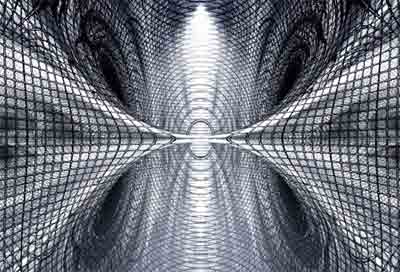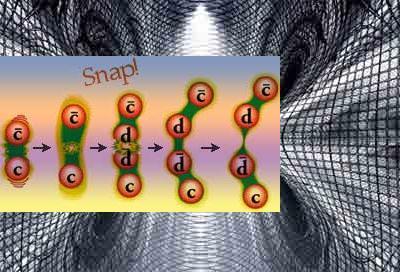نظریه سی پی اچ بر اساس تعمیم سرعت نور از انرژی به ماده بنا شده است.
سی پی اچ در ژورنالها
|
میدان نیروهای رنگی - کوارک گلئون
|
|||||
|
Color-Force Fieldکوارکها در داخل هادرونها گلئون رد و بدل می کنند. بهمین دلیل فیزیکدانان در مورد میدان رنگ - نیرو صحبت می کنند که گلئونها، کوارکها را بطرف یکدیگر می رانند. The quarks in a given hadron madly exchange gluons. For this reason, physicists talk about the color-force field which consists of the gluons holding quarks together. If one of the quarks in a given hadron is pulled away from its neighbors, the color-force field "stretches" between that quark and its neighbors. In so doing, more and more energy is added to the color-force field as the quarks are pulled apart. At some point, it is energetically cheaper for the color-force field to "snap" into a new quark-antiquark pair. In so doing, energy is conserved because the energy of the color-force field is converted into the mass of the new quarks, and the color-force field can "relax" back to an unstretched state.
کنش قوی کوارکها را به یکدیگر متصل می کند
Residual Strong Force
Weak شش نوع کوارک و شش نوع لپتون وجود دارد. همه مواد موجود در جهان از اینها ساخته شده اند. There are six kinds of quarks and six kinds of leptons. But all the stable matter of the universe appears to be made of just the two least-massive quarks (up quark and down quark), the least-massive charged lepton (the electron), and the neutrinos. نیروی هسته ای ضعیف موجب می شود که کوارکهای سنگین به کوارکهای سبکتر واپاشیده شوند. Weak interactions are responsible for the decay of massive quarks and leptons into lighter quarks and leptons. When fundamental particles decay, it is very strange: we observe the particle vanishing and being replaced by two or more different particles. Although the total of mass and energy is conserved, some of the original particle's mass is converted into kinetic energy, and the resulting particles always have less mass than the original particle that decayed.
Electroweak Physicists had long believed that weak forces were closely related to electromagnetic forces. Eventually they discovered that at very short distances (about 10-18 meters) the strength of the weak interaction is comparable to that of the electromagnetic. On the other hand, at thirty times that distance (3x10-17 m) the strength of the weak interaction is 1/10,000th than that of the electromagnetic interaction. At distances typical for quarks in a proton or neutron(10-15 m) the force is even tinier.
In fact, the weak and electromagnetic
forces have essentially equal strengths. This is because the
strength of the interaction depends strongly on both the mass of
the force carrier and the distance of the interaction. The
difference between their observed strengths is due to the huge
difference
1 2 3 4 5 6 7 8 9 10 11 12 13 14 15 16 17 18 19 20 21 22 23 24 25 |
|
Sub quantum space and interactions from photon to fermions and bosons |
|
نامه سرگشاده به حضرت آیت الله هاشمی رفسنجانی |
آرشیو موضوعی

از آغاز کودکی به پدیده های فیزیکی و قوانین حاکم بر جهان هستی کنجکاو بودم. از همان زمان دو کمیت زمان و انرژی بیش از همه برایم مبهم بود. می خواستم بدانم ماهیت زمان چیست و ماهیت انرژی چیست؟



